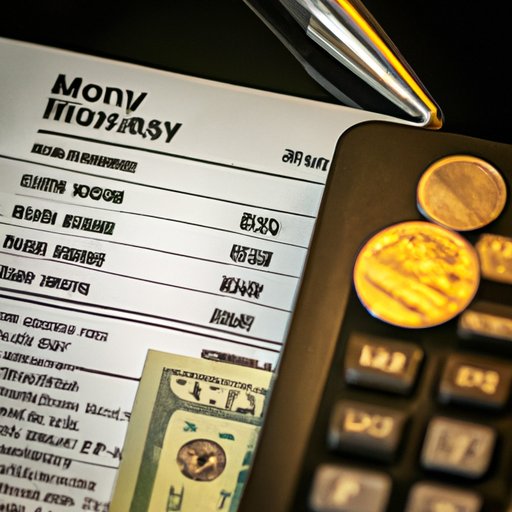
Introduction
Saving money and earning interest on those savings can be a wise financial decision, but it’s essential to choose the right type of account. One option to consider is a money market account, which offers a higher interest rate than traditional savings accounts while still allowing easy accessibility. Understanding how money market accounts work is vital to making informed choices on your financial investments. In this article, we’ll explore the ins and outs of money market accounts, how they differ from savings accounts, and expert tips for maximizing returns.
Money Market Accounts: A Beginner’s Guide to Understanding How They Work
A money market account is a type of savings account that typically earns a higher interest rate than traditional savings accounts. It is often favored by those who want to keep their cash in a relatively low-risk investment while earning a higher return.
Money market accounts are usually offered through banks and credit unions and offer features of both checking and savings accounts. For example, many money market accounts come with check-writing privileges, debit cards, and ATM access.
One significant difference between money market accounts and traditional savings accounts is the minimum balance requirements. Money market accounts typically require a more substantial initial deposit and minimum balance to open and remain in the account. Additionally, money market accounts often come with tiered interest rates, meaning that the interest rate will vary depending on the account’s balance.
Maximizing Returns: How to Make Money in a Money Market Account
One of the primary benefits of a money market account is the higher interest rate, but there are variables that affect this rate. The factors that affect the interest rate of a money market account include the current market rate, the economic environment, and the institution offering the account.
To maximize returns on a money market account, individuals should consider several strategies. One way is to compare interest rates offered by different financial institutions and choose the highest rate. Another strategy is to regularly monitor and adjust the account’s balance to fall within the highest rate tier.
It is also beneficial to compare different types of money market accounts, such as traditional money market accounts, government money market accounts, and insured money market accounts. Each account differs in its level of risk and reward, so understanding these differences is crucial to making an informed choice.
The Benefits and Risks of Investing in a Money Market Account
Investing in a money market account has several advantages, such as providing a secure investment option, easy accessibility to the funds, and higher interest rates than savings accounts. Money market accounts are also insured by the Federal Deposit Insurance Corporation (FDIC) for up to $250,000.
However, money market accounts are not without their risks. Potential risks and limitations of a money market account include interest rate fluctuations, minimum balance requirements, and early withdrawal penalties. Additionally, returns on money market accounts may be lower than riskier investments, such as stocks.
When considering investing in a money market account, it’s essential to compare other investment options. Consider your personal financial goals, risk tolerance, and investment horizon before making your decision.
Money Market Accounts vs. Savings Accounts: What You Need to Know
While money market accounts and savings accounts share similarities, such as being low-risk savings options, there are significant differences to consider. For one, money market accounts often offer higher interest rates than traditional savings accounts, but they also require a higher minimum balance.
Savings accounts often come with fewer restrictions, such as check-writing and withdrawal limitations, but typically offer lower interest rates. Money market accounts have features of both checking and savings accounts, with check-writing privileges, debit cards, and ATM access.
When choosing between a money market account and a savings account, consider factors such as your current savings balance, your need for liquidity, and your investment objectives.
How to Choose the Best Money Market Account for Your Financial Goals
Choosing the best money market account for your financial goals requires evaluating several factors. Start by comparing interest rates offered by different financial institutions, checking the account’s minimum balance requirements, and any account fees.
It’s also essential to consider the account’s flexibility, such as check-writing privileges and ATM access, as well as the level of risk associated with the account.
Additionally, consider whether the institution offering the account is FDIC-insured, which can protect your investment in the event of the institution’s failure.
The Inner Workings of a Money Market Account: How Interest Rates, Withdrawals, and Deposits Impact Your Return
Interest rates play a critical role in a money market account’s return. As the Federal Reserve adjusts the interest rate, the rate on money market accounts will change. Additionally, the account balance can impact the interest rate earned, as some money market accounts offer tiered interest rates.
Withdrawals and deposits can also impact the return on a money market account. Withdrawals before the account’s maturity date may subject the account to early withdrawal fees, and deposits or increases to the account’s balance can raise the interest rate earned.
Expert Tips for Making the Most of Your Money Market Account Investment
Financial experts offer several strategies for making the most of a money market account investment, such as regularly reviewing and comparing interest rates and keeping balances within the highest tier for the highest interest rate. Additionally, experts advise monitoring the account’s fees and regulations and considering factors such as FDIC insurance and the institution’s reputation.
Conclusion
Money market accounts offer an excellent way to earn interest on your savings while maintaining a relatively low level of risk. Understanding how money market accounts work and the various types of accounts available is crucial to maximizing returns and achieving your financial goals. By considering factors such as interest rates, minimum balance requirements, and account fees, you can choose the best money market account for your individual circumstances.




